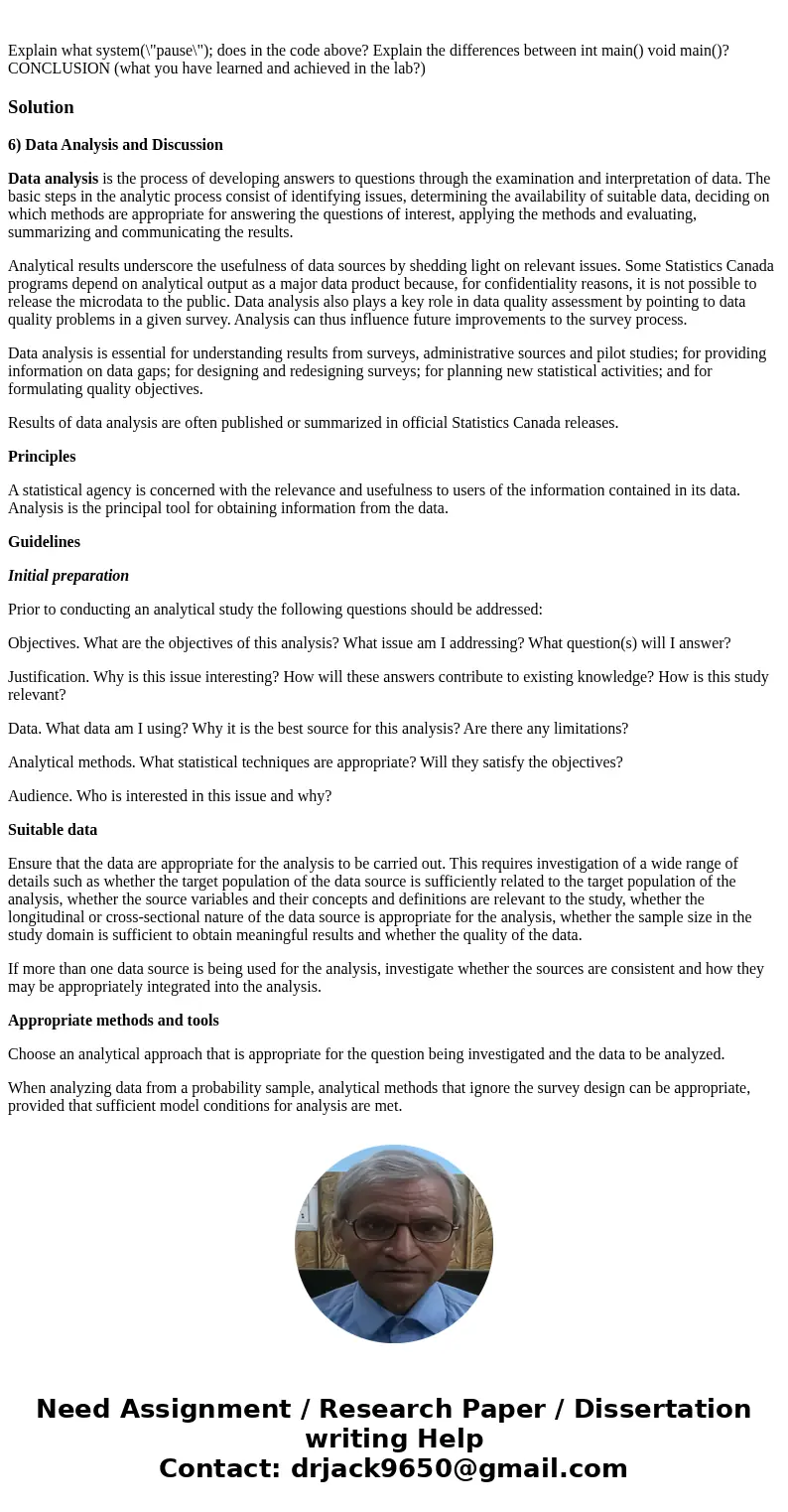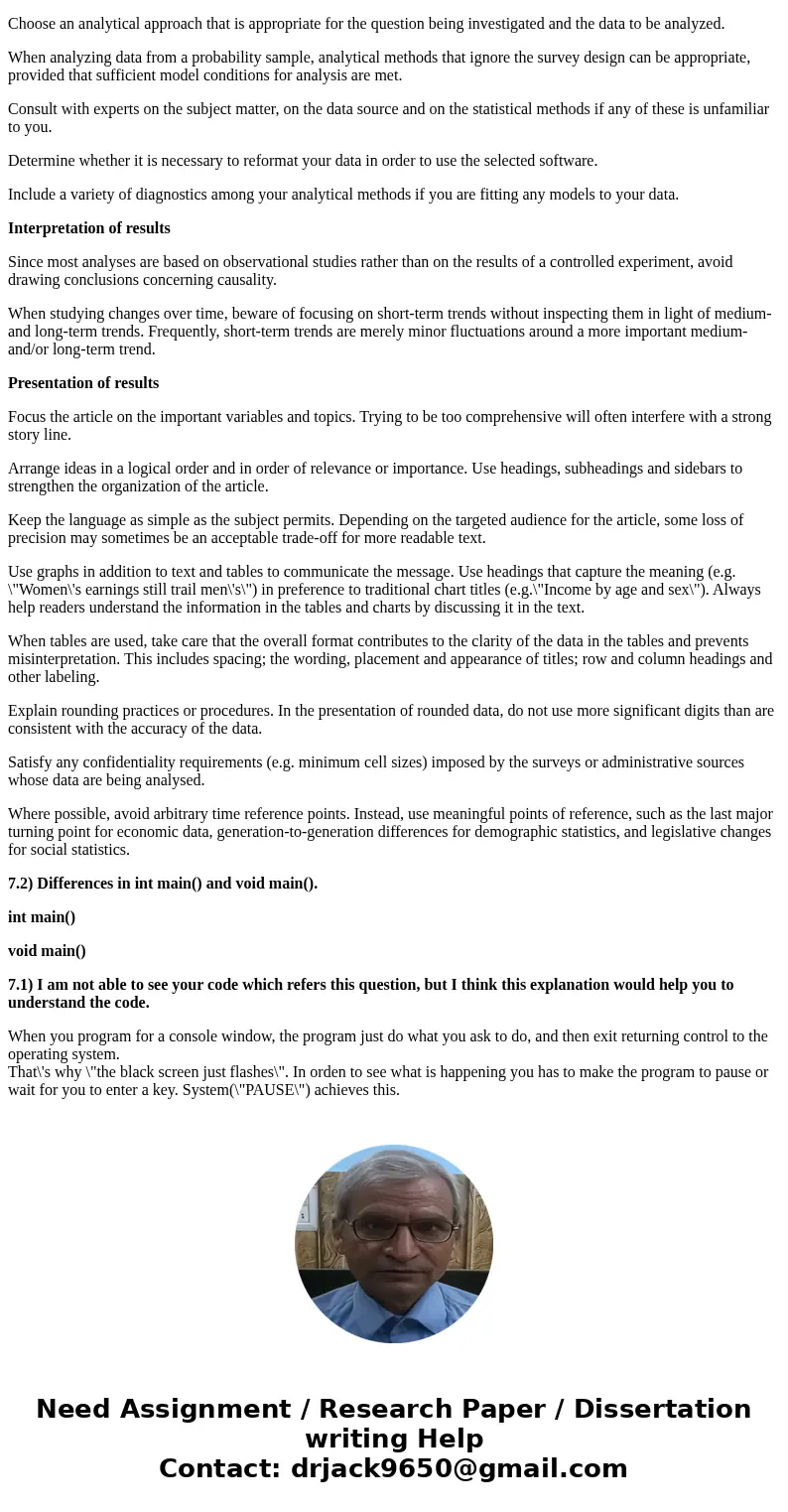Explain what systempause does in the code above Explain the
Solution
6) Data Analysis and Discussion
Data analysis is the process of developing answers to questions through the examination and interpretation of data. The basic steps in the analytic process consist of identifying issues, determining the availability of suitable data, deciding on which methods are appropriate for answering the questions of interest, applying the methods and evaluating, summarizing and communicating the results.
Analytical results underscore the usefulness of data sources by shedding light on relevant issues. Some Statistics Canada programs depend on analytical output as a major data product because, for confidentiality reasons, it is not possible to release the microdata to the public. Data analysis also plays a key role in data quality assessment by pointing to data quality problems in a given survey. Analysis can thus influence future improvements to the survey process.
Data analysis is essential for understanding results from surveys, administrative sources and pilot studies; for providing information on data gaps; for designing and redesigning surveys; for planning new statistical activities; and for formulating quality objectives.
Results of data analysis are often published or summarized in official Statistics Canada releases.
Principles
A statistical agency is concerned with the relevance and usefulness to users of the information contained in its data. Analysis is the principal tool for obtaining information from the data.
Guidelines
Initial preparation
Prior to conducting an analytical study the following questions should be addressed:
Objectives. What are the objectives of this analysis? What issue am I addressing? What question(s) will I answer?
Justification. Why is this issue interesting? How will these answers contribute to existing knowledge? How is this study relevant?
Data. What data am I using? Why it is the best source for this analysis? Are there any limitations?
Analytical methods. What statistical techniques are appropriate? Will they satisfy the objectives?
Audience. Who is interested in this issue and why?
Suitable data
Ensure that the data are appropriate for the analysis to be carried out. This requires investigation of a wide range of details such as whether the target population of the data source is sufficiently related to the target population of the analysis, whether the source variables and their concepts and definitions are relevant to the study, whether the longitudinal or cross-sectional nature of the data source is appropriate for the analysis, whether the sample size in the study domain is sufficient to obtain meaningful results and whether the quality of the data.
If more than one data source is being used for the analysis, investigate whether the sources are consistent and how they may be appropriately integrated into the analysis.
Appropriate methods and tools
Choose an analytical approach that is appropriate for the question being investigated and the data to be analyzed.
When analyzing data from a probability sample, analytical methods that ignore the survey design can be appropriate, provided that sufficient model conditions for analysis are met.
Consult with experts on the subject matter, on the data source and on the statistical methods if any of these is unfamiliar to you.
Determine whether it is necessary to reformat your data in order to use the selected software.
Include a variety of diagnostics among your analytical methods if you are fitting any models to your data.
Interpretation of results
Since most analyses are based on observational studies rather than on the results of a controlled experiment, avoid drawing conclusions concerning causality.
When studying changes over time, beware of focusing on short-term trends without inspecting them in light of medium-and long-term trends. Frequently, short-term trends are merely minor fluctuations around a more important medium- and/or long-term trend.
Presentation of results
Focus the article on the important variables and topics. Trying to be too comprehensive will often interfere with a strong story line.
Arrange ideas in a logical order and in order of relevance or importance. Use headings, subheadings and sidebars to strengthen the organization of the article.
Keep the language as simple as the subject permits. Depending on the targeted audience for the article, some loss of precision may sometimes be an acceptable trade-off for more readable text.
Use graphs in addition to text and tables to communicate the message. Use headings that capture the meaning (e.g. \"Women\'s earnings still trail men\'s\") in preference to traditional chart titles (e.g.\"Income by age and sex\"). Always help readers understand the information in the tables and charts by discussing it in the text.
When tables are used, take care that the overall format contributes to the clarity of the data in the tables and prevents misinterpretation. This includes spacing; the wording, placement and appearance of titles; row and column headings and other labeling.
Explain rounding practices or procedures. In the presentation of rounded data, do not use more significant digits than are consistent with the accuracy of the data.
Satisfy any confidentiality requirements (e.g. minimum cell sizes) imposed by the surveys or administrative sources whose data are being analysed.
Where possible, avoid arbitrary time reference points. Instead, use meaningful points of reference, such as the last major turning point for economic data, generation-to-generation differences for demographic statistics, and legislative changes for social statistics.
7.2) Differences in int main() and void main().
int main()
void main()
7.1) I am not able to see your code which refers this question, but I think this explanation would help you to understand the code.
When you program for a console window, the program just do what you ask to do, and then exit returning control to the operating system.
That\'s why \"the black screen just flashes\". In orden to see what is happening you has to make the program to pause or wait for you to enter a key. System(\"PAUSE\") achieves this.


 Homework Sourse
Homework Sourse